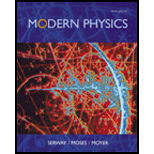
Concept explainers
(a)
The number of
(a)
Answer to Problem 8P
The number of
Explanation of Solution
Write the relation between the number of
Here,
Given that
Write the expression for
Here,
Rearrange the above equation.
Write the expression for
Here,
Rearrange the above equation.
Write the expression for
Here,
Rearrange the above equation.
Write the expression for
Here,
Rearrange the above equation.
Conclusion:
Substitute
Substitute
Substitute
Substitute
Therefore, the number of
(b)
The number of
(b)
Answer to Problem 8P
If the kinetic energy of the incident particle are doubled, then the number of
Explanation of Solution
It is given that
From Equation 4.16, it is clear that by doubling the kinetic energy of the incident particle
Using the above condition, write the equation for
Conclusion:
Therefore, If the kinetic energy of the incident particle are doubled, then the number of
(c)
The number of
(c)
Answer to Problem 8P
The number of
Explanation of Solution
Write the expression for
Here,
Rearrange the above equation.
The number of copper nuclei per unit area is same as the number of copper nuclei per unit volume multiplied with foil thickness.
Write the number of copper nuclei per unit area.
Write the number of gold nuclei per unit area.
Conclusion:
Substitute
Therefore, the number of
Want to see more full solutions like this?
Chapter 4 Solutions
Modern Physics
- A certain particle of mass m has momentum of magnitude mc.What are (a) beta, (b) gama, and (c) the ratio K/E0?arrow_forwardIn a scattering experiment, you concentrate on Alpha particles with impact parameters b=0, 1×10^-3, and 1×10^0 mm. For which b will the behavior of the Alpha particle be very different in Thomson's and Rutherford's models and for which will it be nearly similar?arrow_forwardPellets of mass 2.0 g are fired in parallel paths withspeeds of 120 m/s through a hole 3.0 mm in diameter.How far from the hole must you be to detect a 1.0-cmdiameter spread in the beam of pellets?arrow_forward
- Thermal neutrons are incident on a crystal whose principal Bragg plane spacing is 3.0Å. If a first-order Bragg reflection from the planes is found at 30°, what is the kineticenergy of the thermal neutrons (mass = 1.67 × 10-27kg)?arrow_forwardWhat is the Compton scattering angle for gamma rays which have awavelength of 10.00 pm after scattering, 9.67 pm before?arrow_forwardAt what speed must a beam of neutrons travel so that its associated wavelength is 2 Amstrongs?arrow_forward
- In a Millikan oil-drop experiment the terminal velocity of the droplet is observed to be 1.3 mm/s. The density of the oil is r 900 kg/m3, and the viscosity of air is h 1.82 x 10-5 kg/m. s. Calculate (a) the droplet radius, (b) the mass of the droplet, and (c) the coeffi cient of friction.arrow_forwardIn an alpha particle (42He) scattering experiment, using a thin gold (19779Au) foil, the initial kinetic energy of the alpha particle is 2.0MeV. What is the potential energy of the alpha particle/gold nucleus system at closest impact?arrow_forwardAttenuation coefficient of bone is 600 m⁻¹ for x-rays of energy 20 keV and intensity of beam of x-rays is 20 Wm⁻², then intensity of beam after passing through a bone of 4mm isarrow_forward
- How many photons are contained in a beam of electromagnetic radiation of total power 180W if the source is (a) an AM radio station of 1100kHz (b) 8.0-nm x-rays and (c) 4.0-MeV gramma rays?arrow_forwardDuring the deep X-ray therapy high energy X-rays are used. They are filtered by passing them through copper and aluminium plates. If the copper plate has thickness ?1 = 2 mm and aluminium plate ?2 =3 mm, find reduction in X-ray beam intensity. Linear attenuation coefficients for copper and aluminium are ?1 = 0.32 cm‐¹, and ?2 = 0.15 cm‐¹, respectively.arrow_forwardAn electron has a total energy of 5 MeV. a. Find its momentum in units of MeV/c. and what is the Beta value, if you are able to find it? if not, don't worry about it. Thanks!arrow_forward
 Modern PhysicsPhysicsISBN:9781111794378Author:Raymond A. Serway, Clement J. Moses, Curt A. MoyerPublisher:Cengage Learning
Modern PhysicsPhysicsISBN:9781111794378Author:Raymond A. Serway, Clement J. Moses, Curt A. MoyerPublisher:Cengage Learning Classical Dynamics of Particles and SystemsPhysicsISBN:9780534408961Author:Stephen T. Thornton, Jerry B. MarionPublisher:Cengage Learning
Classical Dynamics of Particles and SystemsPhysicsISBN:9780534408961Author:Stephen T. Thornton, Jerry B. MarionPublisher:Cengage Learning

